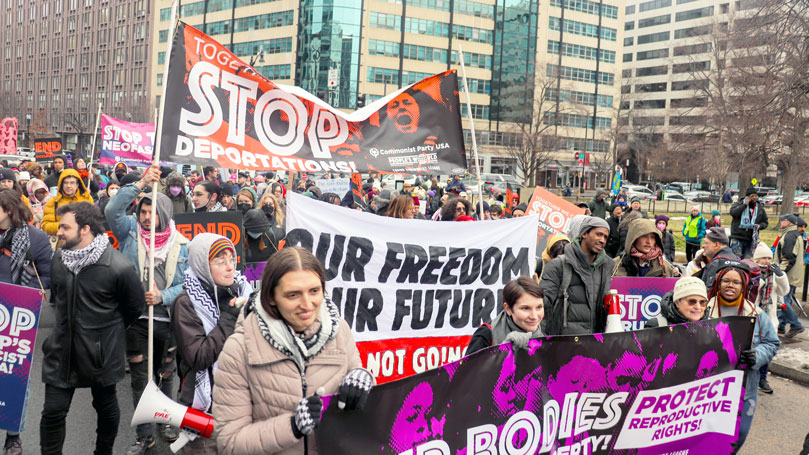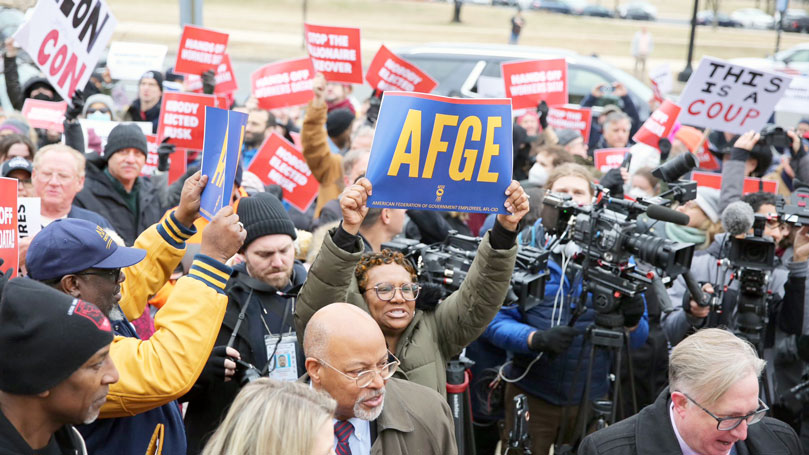
Keynote address to the CPUSA National Committee by Joe Sims on Feb. 2, 2025.
Well comrades, we’re in for a fight aren’t we? But that doesn’t surprise us. The initial days with Mr. Trump and Company are playing out just as we said they would. Today, we want to address some of the key questions before us as we confront the most right-wing administration in our memory, and perhaps the most right wing in the history of the country. And while it likely is the most right-wing administration — Trump’s Executive Orders already underscore that — we hasten to add it is not the strongest, nor is it the most powerful administration.
Let’s remember that this was an election won on the margins by less than 1.5% of the vote. There was no national realignment. There was no move to the right among the working class. Nor did the election provide MAGA with a compelling mandate — and we’ll be damned if they’re going to shove one down our throats! The American people showed that the other day by their widespread reaction to the spending freeze. The freeze was cruel, it was unusual, and tactically, it was just plain stupid. The rejection of the proposed freeze in broad quarters resulted in the first major defeat for the Project 2025 agenda — but it won’t be the last.
However, the new administration’s weakness is not only a matter of percentages. If you think about it, it’s a product of what got it elected in the first place: mass alienation from the political process and from both political parties; working-class anger at high prices; extreme wealth inequality; and the ongoing wars and genocides. Add to that the whipping up of racist, sexist, and homophobic hate which was central to the GOP campaign. In other words, Trump’s victory is based on the unstable ground of U.S. imperialism’s deep systemic crisis.
A dangerous situation
That said, with MAGA controlling all three branches of government, the situation is extremely dangerous. It would be beyond foolish to underestimate it.
Our friends in the labor movement are calling what has happened since January 20th “shock and awe.” To me, a better word was introduced into the English language from the original German by the Nazis — blitzkrieg — an attempt to overcome the opposition by the use of overwhelming force. And that’s what we’re seeing: an attempt by means of Executive Orders and legislation to overcome the democratic opposition with overwhelming force.
As expected, immigrant labor is the first, and what MAGA expects to be the easiest, target. But if easy is what they expect, they have another thing coming. All across the country, immigrant rights organizations and their allies in labor and other movements are joining together to defend migrant families. We’re proud that some of our clubs and districts are on the frontlines of this fight, but others have to get up to speed. We can’t say we’re on top of this issue the way we need to be. The Laken Riley bill, which requires the indefinite detention without trial of any non-citizen accused of theft, is a case in point. They are treating migrants like enemy combatants and terrorists. It’s a shame and disgrace that Democrats in the House and Senate allowed this to occur. Some 48 voted for it in the House. It had two co-sponsors and 12 votes in the Senate.
The truth is that some in the Democratic Party are moving to the right and bowing down to the MAGA billionaire power. The Crucial Communism Teaching Act is another example of this capitulation. This McCarthyite legislation passed the House of Representatives in December with only 62 dissenting votes, some of whom were Republicans. Then there’s the Stop Terrorism Financing Bill, aimed at non-profits. And while after a mass campaign, 40 Democrats changed their vote, 15 voted for it, providing MAGA a bipartisan cover. That’s the MAGA strategy: lay the basis for a MAGA governing majority with a sliver of Democratic support. In the absence of a strong counter movement to stiffen the spine of some Democratic politicians, it could work. That’s why the January 18th protests in D.C. and around the country were so important. What hammered in Trump in his first term were the demonstrations that emerged the day after the election and that continued through the inauguration and beyond.

Resistance 2.0
Those protests didn’t happen this time around. Their absence was interpreted as a defeat for the resistance and a grudging acceptance of the Trump victory. But nothing was further from the case. The anti-MAGA movement was not rolling over. Just after the election, 120,000 met online in a mass meeting organized by the Working Family Party and 200 other organizations. In addition, several other mass online meetings organized by Win With Black women, MoveOn and others brought together tens of thousands. The point here is that folks are taking stock, making plans, and preparing for what’s to come in hopefully smarter, better coordinated, and more strategic ways.
The fightback going forward will occur over a wide terrain and on multiple fronts: political, economic, legal, ideological, cultural. It will be largely, but not entirely, defensive in character. Coalitions will come together in response to the various points of the MAGA attack. Initial responses as measured by the People’s March, were from the women’s movement, environmental groups, the ACLU, nonprofits and community-based organizations. A few local labor unions participated. Many of the tens of thousands who showed up did so spontaneously. Our party, which had an outstanding contingent of over 100, and DSA were apparently the only organized socialist and communist organizations that participated. We salute all of those who showed up for their courage and their initiative and leadership, particularly the Women’s March initiators. To show up and protest was no small thing, particularly when compared to those who didn’t.
On the other hand, we should be careful not to draw the wrong conclusions. Of course, there’s some confusion, disarray, and hesitation in the camps of the democratic opposition. At the same time, the people’s movement knows it’s going to be playing defense. A long and protracted struggle lies ahead. Given the nature of what we’re fighting, some may be thinking it’s smart not to rush headlong into battle without first taking measure of the class enemy’s initial points of attack and its relative strengths and weaknesses. They may be thinking, “Better to conserve one’s forces and carefully consider how and when to respond.”
Depending on the issues and circumstances, some will take the initiative and lead, while others will hold their fire. And that’s okay. Movements take time to gather strength and momentum. We cannot control the pace of struggle. What we can control is how we respond as the pace unfolds. And that means working in the communities, campuses, neighborhoods, and workplaces, building unity and taking action in defense of our class around the basic issues. That’s critical — initiative is in the hands of those who take it.
Some are preparing to do just that. We have heard from some elected officials and a few in the labor movement that they are ready for the MAGA offensive. With respect to the labor movement, the recent decision of SEIU to rejoin the AFL-CIO is an encouraging sign as the unions get ready for attacks on immigrant workers and public employees who are now in MAGA’s crosshairs.
As the struggle unfolds, the Communist Party’s role is to keep close to the grassroots and take initiative in concert with others, keeping uppermost in mind the unity and interests of the broader movement.
What are the features of the new political moment?
A new political moment
Here, our strategy and tactics must take careful measure of what is new and different in the current situation. Can it be said that with the last election we have entered a new political moment that in many ways breaks sharply with the election of past administrations? If so, what are its features and what does it mean for our political work going forward?

Consider, for example, the open, undisguised entry of right-wing tech and banking billionaires into government. According to the New York Times, the tech billionaires have stepped in to provide “elite human capital” to staff the new administration. It’s these forces, at Musk’s direction, who are dismantling the Department of Education, USAID, and other agencies. Then, of course, there are the already vetted fascist-minded MAGA personnel lined up to enter government with the goal of implementing the Project 2025 agenda. Both the tech right and MAGA forces have openly expressed their goal of not only gutting the government but also of becoming the dominant force in the ruling class. With their newly acquired hegemony, they hope to redesign society as a whole. Musk calls it “saving civilization.” I take him to mean saving Western, white, Christian civilization.
Have we appreciated the deep level of anger?
We have to consider what’s new with respect to the Democratic Party. With rare exceptions, its leadership seemed completely unprepared for MAGA’s ascendance. The issue is not just the role that it has now and will play in the future. Clearly it has a role: what other electoral vehicles are there at this stage? Deep thought must be given as to whether we have sufficiently appreciated the level of anger in important sections of the working class directed at the Democrats, particularly in the midwest. Do we understand the fury that has led workers in several election cycles now to vote for the GOP? And do we realize that the fury is not just directed at the Democratic Party, but at the system as a whole, at what they call “the establishment”? We’re talking about government, business, the mass media — you name it. In his inaugural address, Trump called it “the radical and corrupt establishment [that] has extracted power and wealth from our citizens.”
Folks are “too through”
Clearly there’s a strong feeling that the system isn’t working: that it needs to be torn down, broke up and changed fundamentally. And folks don’t care who brings that change. During the subprime crisis, a young Black Democrat named Obama promised he would deliver it. And some of the same workers who are now voting GOP held on to that promise and elected him twice. But in the eyes of many, nothing happened. Now, simply put, folks are “too through.” And they’ve turned to Trump now twice. He has taken that anger and twisted it — blaming immigrants, woke politics, China, everything and anything except those really responsible.
But here’s the thing: isn’t this anger, this fury, this desire to tear the system down, a symptom of a deep radicalization in the working class that’s taken place, notwithstanding its being hijacked by the right? And when we say radicalization, we don’t necessarily mean radicalization to the left, but rather a deep and abiding anger at the top, at what Paul Robeson used to call “big white folks,” an anger that could go in either direction. And if it does indicate such a radicalization process, how do we respond to that desire for change? Do we write these workers off? Some would like to. But if in the 1930s we had taken this attitude toward a section of white workers, the mass production industries would never have been organized. So that’s clearly not an option.
But here’s another thing to consider: are we ourselves calling for such basic change? The Democrats aren’t — at least not most of them. They’ve been busy defending the system, the status quo, against the looming right-wing threat. But why aren’t we? After all, we’re a revolutionary, working-class party. Or does our campaigning for democracy appear to be a defense of the status quo that many have given up on and implicitly a defense of the Democratic Party? That’s the subjective side of the problem.
Objectively, however, there’s another issue: Today fascist-minded billionaires — with two of the wealthiest hailing from South Africa — have openly seized hold of the reins of state power. There are some 13 right-wing billionaires presently in the Cabinet. Given their predominance, how can the struggle against the MAGA right be waged, without addressing their grip on the White House, Congress, and the judiciary? Is it possible to defeat the MAGA fascist power, without defeating the billionaire oligarchy? And when we say the billionaire oligarchy, aren’t we talking about sections of monopoly?

And therefore, isn’t it the case that anti-fascist tasks must be coupled with anti-monopoly tasks, including public ownership and democratic control? Crazy? Perhaps. But for us, not as crazy as eliminating the 14th Amendment and birthright citizenship, which are a bedrock of bourgeois democratic rights, not to mention DEI programs, abortion rights, the NLRB, etc. Will our taking up these anti-monopoly demands result in a narrowing of the anti-fascist coalition? If we were bigger and more influential, perhaps. But we have to be guided by what’s best for us and the class.
Building the party
What’s best for us — and the working class — is to build the party as rapidly as possible in all directions. And to do that, we must feed into the anger that is brewing where we work, live, and struggle. That means fighting like hell at the local level, including running for office. Such campaigns must go after both the GOP and the Democrats. We’re not proposing to treat them equally — we know where the greatest danger lies — but not giving the Democrats a pass either. There’s a way to run by focusing on the issues, stressing the main danger, but also pointing out all who are complicit with the MAGA agenda, including the corporate Democrats and others. The issue is how to do so without falling into a narrow, hopeless, left sectarianism.
Admittedly, it’s a difficult balance to strike. One the hand, to recognize the fascist threat, but on the other, not to be seen as defending a status quo that is indefensible.
As you can see, these issues are opening up basic questions about the electoral process and how we comport ourselves in relation to it. As we have said from this platform many times before, we cannot fully be a political party if we don’t stand for elections. The fact that we haven’t done so for many years now — decades even — has been an unfortunate side effect of our decision not to mount national campaigns in the late 80s. What began as a temporary tactic, sadly turned into a longstanding policy, the result of which is that our political profile has largely disappeared from the national, state, and local political scene. When combined with a conscious deemphasis on taking initiative, the inevitable result was a tailing of the Democratic Party.
A related problem was the simultaneous watering down of Marxist basics and the unmistakable seepage of anti-working class concepts into our ranks. And yes, I’m talking about what we used to call right opportunism. I know this is a loaded term for some, but how else do you account for the pressure to change the name and nature of the party, the rejection of the Communist plus concept, the lack of party initiative, the appearance and toleration of competing concepts of party organization, the questioning of the need for clubs, the dissolving of the YCL and youth work, the complete cessation of our organized theoretical work and our journal, Political Affairs?
Importantly, we have taken a number of steps over the last several years, beginning with John Bachtell’s tenure as Party chairman, to course correct by elevating our organizational work, rebuilding our club and district structures, restoring our public presence and yes, encouraging Communist candidacies. We’ve also reintroduced the systematic introduction of Marxist-Leninst educational basics. Taken as a whole, we described all of these measures as part of the Party’s rebuilding process. One thing that we haven’t rebuilt, however, is our theoretical work. Think about it: when was the last time we had a basic article on women’s equality, the national question, changes in the working class, new aspects of imperialism, etc. On the struggle for women’s equality, it’s been at least 40 years! It’s way past time, comrades, that we relaunch Political Affairs, and direct a collective to organize our theoretical work.

Comrades, all this points to a basic precept: the battle of ideas is a fundamental feature of the global fight between labor and capital. Ever present in this struggle is the danger of dilution from the right and distortion from the left — right opportunism and left sectarianism. We can’t pretend that they don’t exist. At any given moment, one becomes more prominent than the other, but attention must be paid to both. We neglect doing so to our everlasting peril. It’s true that in a period of rapid growth, addressing immature left sectarianism among new cohorts will be an ongoing issue. And we’ve had our share of these problems. But it’s also true that liquidationist pressures abound, particularly during ebb periods of slow, gradual development. The collapse of the USSR accentuated these tendencies as Parties sought to overcome both a staid and ossified Marxism and the revisionist “new thinking” that replaced it. At the center of the attack was Lenin, a creative Marxism-Leninism, class and democratic struggle, and the role of the Party.
Fighting U.S. imperialism
Speaking of ideological issues, Trump’s inaugural address revealed the importance of continuing to refine our approach to U.S. imperialism. It was an inaugural address brimming with an undisguised, insurgent white nationalism. “We’re going to take the Panama Canal, make Canada the 51st state, snatch up Greenland, rename the Gulf of Mexico” Trump maintained. He continued, “The Monroe Doctrine is back.” But Latin and Central America never accepted that they were U.S. imperialism’s backyard and exclusive sphere of influence. And the national democratic and left movements in the Americas are deeper and more developed than ever before. Mexico is a case in point. They’re not going back either.
Our responsibility in combating this new imperialism means that our priority is to defeat U.S. imperialism here at home. It has not changed its nature, nor can it. But there’s a lot of confusion about this issue. Imperialist globalization has brought with it a host of ideological challenges, including the notion that imperialism no longer exists. For example, the term “empire” has replaced imperialism as an operative concept in wide circles and with it a rejection of agency for the working class in the developed capitalist countries. In this fanciful scenario, workers are part of a Western labor aristocracy, whose class interest aligns with the imperialist bourgeoisie.
Related to this is the idea that the U.S. is the planet’s only imperialist country and that inter-imperialist rivalries are a thing of the past. But what happened to the European Union and Japan as centers of inter-imperialist rivalry? Then there is the concept of multi-polarity and its application to the current international balance of forces with some not seeing that U.S. imperialism, while still dominant, is being challenged by both traditional and emerging imperial powers. Here it is vital to be objective and see points of convergence and difference between various imperialist groups and countries.
The Trump administration has its sights set on China. And as we know, there is a consensus in the ruling class on confronting the People’s Republic, whether it was the social democratic foreign policy of Biden or the white nationalist one of Bannon and Trump. With Trump, the Cold War 2.0 is sure to be intensified. Gaza, Ukraine, the placing of Cuba back on the “State Sponsors of Terrorism” list, along with Venezuela remain key issues upon which vigilance must be maintained. Needless to say, the achievement of the Gaza ceasefire is an important development. However, Trump’s proposal to relocate the Palestinian people cannot be ignored.
A big fight ahead
So we’ve got a big fight ahead around a broad range of issues. The next 100 days will be critical as will the following couple of months when the campaign for the 2026 midterm elections will begin.
Let us pledge this afternoon to continue the course set by the 32nd Convention: to build the party, to fight the MAGA right tooth and nail by strengthening the people’s front, and to fight U.S. imperialism with everything we have. If we do that, and do it well, we’ll be well on the way to building the mass party of action our country so desperately needs.
Images: CPUSA members at the Jan. 18 People’s March in D.C. (CPUSA); D.C. protestors at People’s March (CPUSA); Union members protest Elon Musk and DOGE at the Dept. of Labor building in D.C. by People Who Work (X); CPUSA members at the Jan. 18 People’s March in D.C. (Dylan M. / CPUSA); CPUSA at the January 13 March on Washington for Gaza in 2024 (Cameron Orr / CPUSA)


 Join Now
Join Now